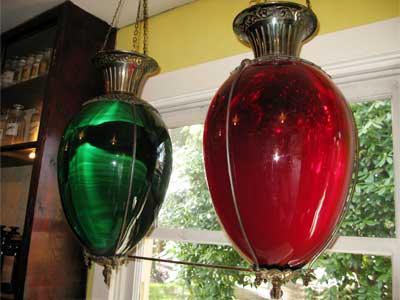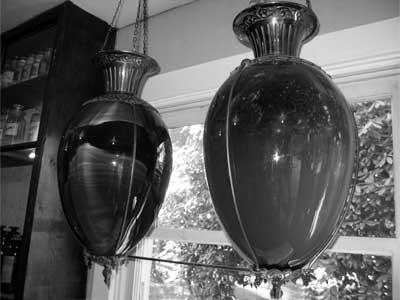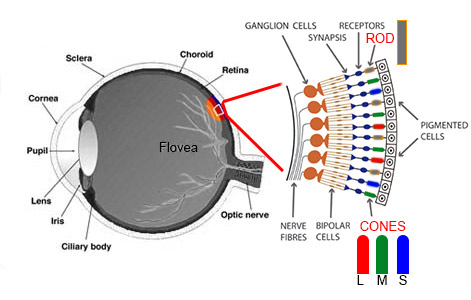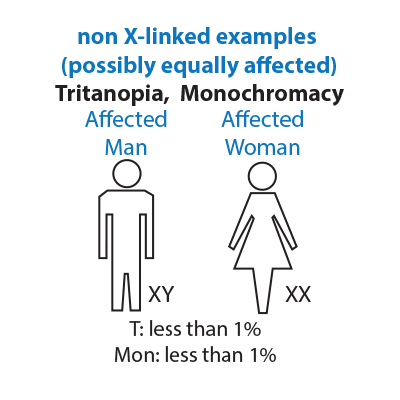Monochromacy


Monochromacy is a rare form of colour blindness in which a person's eyes are unable to receive the red-green-blue light of the colour spectrum. In some cases it is also known as Achromatopsia.
Listen to how the words sound:
How does this happen?

Side view of the eye and close up of rods and cones
In order to view colour the eye has special receptors called rods and cones. As we can see in this diagram, when a person has Monochromacy they are lacking all the cones in their eyes and only the rods are left. There are 3 main forms of Monochromacy:
- Rod monochromacy - only having the rods in the eye
- Cone monochromacy - rods and cones are still in the eye but only one type of cone is working (unlike other forms of colour blindess where at least 2 types of cones are working)
- Cone monochromacy, type II - where there are no rods in the eyes (very rare)
A person with normal vision can distinguish 7 hues while a person who has Monochromacy may only be able to distinguish 1 hue, black and white.
Who can have Monochromacy?
Monochromacy or Achromatopsia is very rare. Achromatopsia means the inability to see color. Another use of the word is for acquired disorders such as cerebral achromatopsia also known as color/vision agnosia, which refers to congenital color vision disorders. With Cerebral achromatopsia, a person cannot perceive colors even though the eyes are capable of distinguishing them. Some sources do not consider Cerebral achromatopsia to be true color blindness, because the failure is of perception, not of vision. However, in this section Achromatopsia is Rod Monochromacy which is a lack of all cones in the eye.
Rod Monochromacy
Achromatopsia is characterized by the following symptoms:
- complete inability to differentiate colors
- severe light sensitivity (photophobia)
- long-sightedness
- involuntary eye movements (nystagmus)
- central depressed vision (scotoma)
Blue-Cone Monochromacy
Blue-Cone is the loss or rearrangement of the genes encoding L- and M-cones. Because of that only blue color receptors (S-cones) and rods are transmitting color and/or brightness information. However, in low-light situations a few colours might be perceived. Like rod monochromacy a person will also have nystagmus, reduced vison and myopia (nearsightedness). There are some reported cases of red-cone(L-cone) or green-cone(M-Cone) monochromacy, but they are extremely rare and unlike blue-cone may not have the same amount of light sensitivity.

Because these rare forms of colour blindness are likely not sex-linked both Male and Female have the equal possiblity of being affected.
Monochromacy is a very rare type of colour blindness. About 1:30,000 and 1:50,000. and it is equally distributed among men and women and is inherited, but it is unclear if it is always sex-linked. However, on the island of Pingelap in Pohnpei, Micronesia about 10% of residents have Achromatopsia and 30% are carriers. This is due to the small gene pool that occurred due to a storm in the 18th century which left very few male survivors, one which had Achromatopsia. The population grew to several thousand, but was reduced again by the introduction of diseases by foreign troops in the 1940's. Currently, the population of the island is about 250. More information on this story can be found in the book by neurologist Oliver Sacks, The Island of the Colorblind.
What are the colour-related hazards?
While a person with Monochromacy is very rare there are still hazards. Consider what it would be like not to be able to see colour when driving in traffic or working with machinery that has coloured lights for danger? People with Monochromacy often learn to associate certain colours with objects and to differentiate some colours by their brightness.
Look at this website about colour and symbols ColourADD